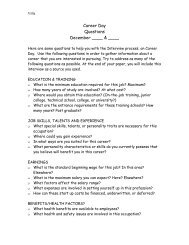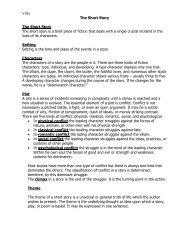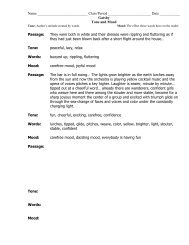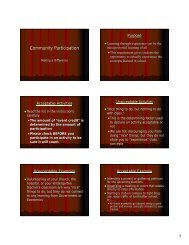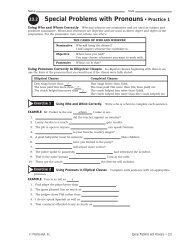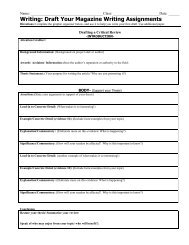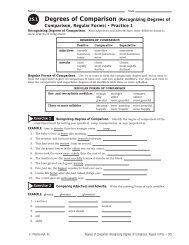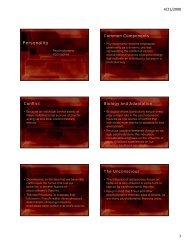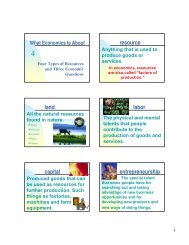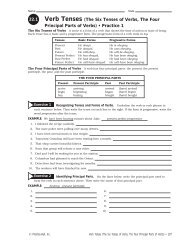complete packet
complete packet
complete packet
You also want an ePaper? Increase the reach of your titles
YUMPU automatically turns print PDFs into web optimized ePapers that Google loves.
Villa<br />
Essential Document<br />
(Please Keep All Year)<br />
English 11
Annotative Steps to Reading:<br />
1. Number the paragraphs. Before you read, take a moment and number the paragraphs.<br />
Then circle the number.<br />
2. Circle: (Paper should have many circles)<br />
A. Key terms: (• key concepts • lesson-based content vocabulary • concept-based vocabulary)<br />
B. Cited authors or names: (• names of people • names of historical events)<br />
C. Other essential words or numbers: (• words that signal relationships (e.g. This led to… or As a result )•<br />
dates • numbers • theories • experiments • repeated • anything relevant to one’s reading purpose)<br />
3. Underline the author’s claims and other information relevant to the reading:<br />
Relevant information might include: • central claims • evidence • details relating to a theology, philosophy, theory<br />
or ideology • facts about a person, place, thing, or idea • descriptions of a person, place, thing, or idea • cause<br />
and effect relationships • data • example • methods • descriptions • facts • or anything else that backs up the<br />
author’s assertion<br />
Things you should know:<br />
• A claim may appear anywhere in the text (beginning, middle, or end).<br />
• A claim may not appear explicitly in the argument, so the reader must infer what it is<br />
• Often, an author will make several claims throughout his or her argument.<br />
• An author may signal his or her claim, letting you know that this is his or her position.<br />
4. Write in the margins: While making connections, clarifying information, or doing other work defined on<br />
this page, write down your thoughts in the margins of the text.<br />
There are 6 strategies for writing in the margins: (Do at least 3 of the 6)<br />
A. Visualizing what authors say will help you clarify complex concepts and ideas.<br />
Ask yourself:<br />
•What does it look like?<br />
•What visual and/or symbol best represents this idea?<br />
B. Summarize paragraphs or sections of the text in order to keep track<br />
C. Clarify or translate complex ideas presented in the text.<br />
D. Connect to your own life or other readings or sections in the reading.<br />
•How does this relate to me?<br />
•How does this idea relate to other ideas in the text?<br />
E. Respond to ideas in the text. Readers often respond to interesting ideas, emotional arguments, provocative<br />
statements, author’s claims, and facts or ideas. You may include any rhetorical devices and/ or strategies<br />
(see other handout)<br />
F. Question both the ideas and your own understanding of the text. Ask good questions to become more<br />
critical readers.<br />
Ask yourself:<br />
• What is the author saying here? • What is the author doing? • What do I understand so far?<br />
• What is the purpose of this section? • What do I agree/disagree with?<br />
**• Who is …? • What is the word…? • When did…? • Where is /or Where was….? • Why is the author…?<br />
How come…?<br />
5. Say, Do, Mean: Answer the following questions somewhere at the bottom of the text.<br />
A. What does the author say? (What is the text about?)<br />
B. What does the author do? (What rhetorical devices or strategies does the author use?)<br />
C. What does the text mean? (What is significant about the text? What is the greater meaning? Or the deeper<br />
understanding?)
Poetry Analysis Steps<br />
Villa<br />
1. Read the poem several times.<br />
2. Define any unknown words<br />
3. Identify: (Pick 2 from any category)<br />
a. Sound Devices: the rhyme scheme, alliteration, consonance, assonance<br />
b. Figurative Language: metaphors, simile, hyperbole, personification<br />
c. Other Poetic Devices: symbolism, irony, allusion<br />
4. Identify the tone of the poem. What diction supports your answer?<br />
5. Identify: Who is the speaker(s) of the poem? Who is the audience?<br />
6. What is taking place in the poem? (action or ideas)<br />
7. What is the central purpose of the poem? (theme)<br />
Early Assessment Program (EAP)<br />
E- explain the author’s argument<br />
A- agree or disagree with the argument<br />
P- provide examples to support your point of view<br />
EAP tips:<br />
1. State your opinion about the topic in your thesis.<br />
2. Analyze / evaluate the main points of the argument.<br />
a. What was the major claim the author makes?<br />
b. What are the strongest claims? What are the wekest?<br />
c. What appeals does the authors use? (Methods of Appeal)<br />
3. Be aware of your audience; take your audience into consideration.<br />
4. Choose evidence that supports your thesis statement.<br />
5. Anticipate opposing points of view (counterclaim)<br />
6. Find some common ground.<br />
7. Maintain a reasonable tone.<br />
8. Organize your essay so that it presents you opposition as effectively as possible.<br />
Introduction:<br />
Background info.<br />
Introduction to subject<br />
Statement of your opinion<br />
Body: (@ least 2<br />
Paragraphs)<br />
Common ground (Topic)<br />
Supporting Evidence: Logical<br />
& Emotional<br />
Address opposing points of<br />
view<br />
Conclusion:<br />
Restatement of opinion<br />
Call for action or agreement<br />
Respond to opposing points<br />
of view
Villa<br />
Alliteration: the repetition of similar sounds in a sequence of words<br />
11 th Grade Literary Terms list<br />
Allusion: In literature, this is a reference to another work. (In the Police song “Wrapped Around Your Finger” Sting writes, “trapped between the<br />
Scylla and Charybdis” in reference to Homer’s Oddyssey.)<br />
Anecdote: A very short story that is told to make a point.<br />
Assonance: repetition of identical or similar vowel sounds, usually those found in stressed syllables that are close to each another (3 examples<br />
are shown in this line: “What large, dark hands are those at the window/ grasping in the golden light”)<br />
Consonance: repetition of the final consonant sounds following different vowel sounds in words close to each other (His blade was stained with<br />
blood.)<br />
Connotation: the association(s) suggested by a word, different from what it literally describes, often referred to as the implied meaning of a word<br />
Denotation: a direct and specific meaning, often referred to as the dictionary meaning of a word Detail: facts, observations, and incidents that<br />
are used to develop a topic<br />
Flashback: a scene in a short story, a novel, a narrative poem, or a play that interrupts the action to show an event that happened earlier.<br />
Foreshadowing: the use of hints or clues in a narrative to suggest what action is to come. Writers use foreshadowing to create interest and build<br />
suspense<br />
Hyperbole: an exaggeration of fact used either for serious or comic effect. (“Her eyes opened wide as saucers.”)<br />
Imagery: words used to create or suggest pictures in the reader’s mind – what we see, hear, smell, feel, or taste. (“The pungent fragrance of<br />
orange blossoms sweetly drifted through the air.” “The stunning blue waters sparkled with brilliant clarity.”)<br />
Irony: A contrast or an incongruity between what is stated and what is meant or between what is expected to happen and what actually happens.<br />
The three kinds of irony are:<br />
verbal irony, in which a writer or speakers says one thing and means something entirely different (Mercutio: “If you look for me<br />
tomorrow, you shall find me a grave man.”)<br />
dramatic irony, in which a reader or an audience knows something that a character in the story or play does not know (readers know<br />
Romeo and Juliet will die)<br />
irony of situation, in which the writer shows a discrepancy between the expected result of some action or situation and its actual result<br />
(It is ironic that the marriage counselor got a divorce.)<br />
Metaphor: a comparison that is only suggested or implied, with no clear indication of a relation between the two items. (“Her face is a wrinkled<br />
leaf.”)<br />
Motif: a reoccurring feature, such as a name, an image, or a phrase, in a work of literature. A motif generally contributes in some way to the<br />
theme of a short story, novel, poem, or play.<br />
Onomatopoeia: the use of a word in which the sound imitates or suggests its meaning. (Hiss, clang, snap, buzz.)<br />
Oxymoron: a phrase where two or more words are <strong>complete</strong>ly opposed. (Sweet sorrow, wise fool, honest thief, short eternity)<br />
Parallel structure: the use of grammatically similar constructions in writing; words, phrases, sentences, paragraphs. (His audition required<br />
singing, dancing, and memorizing a passage)<br />
Personification: a figure of speech in which something nonhuman is given human qualities.(“Grey mist on the sea’s face”)<br />
Satire: A kind of writing that holds up to ridicule or contempt the weaknesses and wrongdoings of individuals, groups, institutions, or humanity<br />
in general. The aim of satire is to set a moral standard for society, and to attempt to persuade the reader to see their point of view through the<br />
force of laughter.<br />
Simile: a figure of speech comparing two essentially unlike things through the use of words “like” or “as” (My love is like a rose)<br />
Symbol: any object, person, place, or action that has a meaning in itself and that also stands for something larger than itself, such as a quality, an<br />
attitude, a belief, or a value. (as a rose is often a symbol of love).<br />
Soliloquy: a monologue in which the character in a play is alone and speaking only to himself or herself; usually shows a significant conflict in<br />
thoughts<br />
Syntax: the way words are arranged to form phrases, clauses and sentences; syntax encompasses word order, sentence length, sentence focus, and<br />
punctuation.<br />
Tone: the author’s attitude toward the book, play or poem’s subject and theme; tone is conveyed through diction and detail.
Angry<br />
Paranoid<br />
Sarcastic<br />
Pleading<br />
Sweet<br />
Numb<br />
Harsh<br />
Cynical<br />
Cheerful<br />
Facetious<br />
Pleasant<br />
Hating<br />
Sharp<br />
Nervous<br />
Disgusted<br />
Loving<br />
Haughty<br />
Condescending<br />
Soothing<br />
Enthusiastic<br />
Melancholic<br />
Snooty<br />
Depressed<br />
Dreamy<br />
Ecstatic<br />
Lighthearted<br />
Agitated<br />
Humble<br />
Sympathetic<br />
Instructive<br />
Seductive<br />
Disinterested<br />
Hollow<br />
Uninterested<br />
Humorous<br />
Cheery<br />
Passive<br />
Manipulative<br />
Persuasive<br />
TONE<br />
Contradictory<br />
Afraid<br />
Aggravated<br />
Tired<br />
Serious<br />
Happy<br />
Calm<br />
Disappointed<br />
Proud<br />
Dejected<br />
Apathetic<br />
Excited<br />
Encouraging<br />
Desperate<br />
Consoling<br />
Superficial<br />
Friendly<br />
Sad<br />
Loud<br />
Artificial<br />
Apologetic<br />
Authoritative<br />
Appreciative<br />
Surprised<br />
Joyful<br />
Ironic<br />
Villa<br />
Miserable<br />
Content<br />
Vibrant<br />
Hurt<br />
Confused<br />
Questioning<br />
Informative<br />
Arrogant<br />
Coarse<br />
Romantic<br />
Upset<br />
Cheerful<br />
Transition Words<br />
Words that can be used to show location:<br />
above behind by near throughout<br />
across below down off to the right<br />
against beneath in back of onto under<br />
along beside in front of on top of<br />
among between inside outside<br />
around beyond into over<br />
Words that can be used to show time:<br />
while first meanwhile soon then<br />
after second today later next<br />
at third tomorrow afterward as soon as<br />
before now next week about when suddenly<br />
during until yesterday finally<br />
Word that can be used to compare two things:<br />
likewise also while in the same way<br />
like as similarly<br />
Words that can be used to contrast two things:<br />
but still although on the other hand<br />
however yet otherwise even though<br />
Words that can be used to emphasize a point:<br />
again truly especially for this reason<br />
to repeat in fact<br />
to<br />
emphasize<br />
Words that can be used to conclude or summarize:<br />
finally as a result to sum up in conclusion<br />
lastly therefore all in all because<br />
Words that can be used to add information:<br />
again another for instance for example<br />
also and moreover additionally<br />
as well besides along with other<br />
next finally in addition<br />
Words that can be used to clarify:<br />
that is for instance in other words
Villa<br />
List of Words to Describe an Author’s Tone<br />
This is a list of words that could be used while examining an author’s tone. Students can use this list when<br />
completing the rhetorical précis or while doing similar work.<br />
Tone<br />
Meaning<br />
apologetic<br />
Sorry<br />
appreciative<br />
grateful; thankful<br />
concerned<br />
worried or interested<br />
critical<br />
finding fault<br />
curious<br />
wanting to find out more<br />
defensive<br />
defending<br />
direct<br />
straightforward; honest<br />
disappointed<br />
discouraged; unhappy because something went wrong<br />
encouraging<br />
optimistic<br />
enthusiastic<br />
excited; energetic<br />
formal<br />
respectful, appropriate behavior<br />
frustrated<br />
angry because of not being able to do something<br />
hopeful<br />
looking forward to something; optimistic<br />
humorous<br />
funny<br />
informal<br />
not formal; relaxed<br />
inspirational<br />
encouraging; reassuring<br />
ironic<br />
different from what is expected or the opposite of what is meant<br />
judgmental<br />
judging others; critical<br />
lighthearted<br />
happy, carefree<br />
mocking<br />
scornful; ridiculing; making fun of someone<br />
negative<br />
unhappy; pessimistic<br />
neutral<br />
neither good nor bad; neither for nor against<br />
nostalgic<br />
thinking about the past; wishing for something from the past<br />
objective<br />
without prejudice; without discrimination; fair<br />
optimistic<br />
hopeful; cheerful<br />
pessimistic<br />
seeing the bad side of things<br />
sarcastic<br />
scornful; mocking; ridiculing<br />
satirical<br />
making fun of something to show its weakness or teach a lesson<br />
sentimental<br />
thinking about feelings, especially when remembering the past<br />
sincere<br />
honest; truthful; earnest<br />
sympathetic<br />
compassionate; understanding of how someone feels<br />
urgent<br />
insistent; saying something must be done soon<br />
Verb List<br />
High-Frequency Charting Verbs<br />
Analyzing Connecting Discussing Illustrating Questioning<br />
Arguing Defining Developing Introducing Stating<br />
Asserting Debating Extending Listing Suggesting<br />
Comparing Clarifying Explaining Offering Summarizing<br />
Contrasting Concluding Interpreting Proving Questioning<br />
Medium-Frequency Charting Verbs<br />
Acknowledging Distinguishing Justifying<br />
Challenging Establishing Predicting<br />
Compiling Generalizing Qualifying<br />
Differentiating Incorporating Substantiating<br />
Use this space to add charting verbs that are not listed above.<br />
Taken from AVID Critical Reading 10.9 and 8.2
Villa<br />
Adjectives to use:<br />
Appearance<br />
Adjectives<br />
adorable<br />
beautiful<br />
clean<br />
drab<br />
elegant<br />
fancy<br />
glamorous<br />
handsome<br />
long<br />
magnificent<br />
old-fashioned<br />
plain<br />
quaint<br />
sparkling<br />
ugliest<br />
unsightly<br />
wide-eyed<br />
Color Adjectives<br />
red<br />
orange<br />
yellow<br />
green<br />
blue<br />
purple<br />
gray<br />
black<br />
white<br />
Condition<br />
Adjectives<br />
alive<br />
better<br />
careful<br />
clever<br />
dead<br />
easy<br />
famous<br />
gifted<br />
helpful<br />
important<br />
inexpensive<br />
mushy<br />
odd<br />
powerful<br />
rich<br />
shy<br />
tender<br />
uninterested<br />
vast<br />
wrong.<br />
Feelings (Bad)<br />
Adjectives<br />
angry<br />
bewildered<br />
clumsy<br />
defeated<br />
embarrassed<br />
fierce<br />
grumpy<br />
helpless<br />
itchy<br />
jealous<br />
lazy<br />
mysterious<br />
nervous<br />
obnoxious<br />
panicky<br />
repulsive<br />
scary<br />
thoughtless<br />
uptight<br />
worried<br />
Feelings (Good)<br />
Adjectives<br />
agreeable<br />
brave<br />
calm<br />
delightful<br />
eager<br />
faithful<br />
gentle<br />
happy<br />
jolly<br />
kind<br />
lively<br />
nice<br />
obedient<br />
proud<br />
relieved<br />
silly<br />
thankful<br />
victorious<br />
witty<br />
zealous<br />
Shape Adjectives<br />
broad<br />
chubby<br />
crooked<br />
curved<br />
deep<br />
flat<br />
high<br />
hollow<br />
low<br />
narrow<br />
round<br />
shallow<br />
skinny<br />
square<br />
steep<br />
straight<br />
wide.<br />
Size Adjectives<br />
big<br />
colossal<br />
fat<br />
gigantic<br />
great<br />
huge<br />
immense<br />
large<br />
little<br />
mammoth<br />
massive<br />
miniature<br />
petite<br />
puny<br />
scrawny<br />
short<br />
small<br />
tall<br />
teeny<br />
teeny-tiny<br />
tiny<br />
Sound Adjectives<br />
cooing<br />
deafening<br />
faint<br />
hissing<br />
loud<br />
melodic<br />
noisy<br />
purring<br />
quiet<br />
raspy<br />
screeching<br />
thundering<br />
voiceless<br />
whispering<br />
Time Adjectives<br />
ancient<br />
brief<br />
early<br />
fast<br />
late<br />
long<br />
modern<br />
old<br />
old-fashioned<br />
quick<br />
rapid<br />
short<br />
slow<br />
swift<br />
young<br />
Taste/Touch<br />
Adjectives<br />
bitter<br />
delicious<br />
fresh<br />
greasy<br />
juicy<br />
hot<br />
icy<br />
loose<br />
melted<br />
nutritious<br />
prickly<br />
rainy<br />
rotten<br />
salty<br />
sticky<br />
strong<br />
sweet<br />
tart<br />
tasteless<br />
uneven<br />
weak<br />
wet<br />
wooden<br />
yummy<br />
Touch Adjectives<br />
boiling<br />
breeze<br />
broken<br />
bumpy<br />
chilly<br />
cold<br />
cool<br />
creepy<br />
crooked<br />
cuddly<br />
curly<br />
damaged<br />
damp<br />
dirty<br />
dry<br />
dusty<br />
filthy<br />
flaky<br />
fluffy<br />
freezing<br />
hot<br />
warm<br />
wet<br />
Quantity Adjectives<br />
abundant<br />
empty<br />
few<br />
full<br />
heavy<br />
light<br />
many<br />
numerous<br />
sparse<br />
substantial
Villa<br />
Rhetoric Analysis Steps<br />
1) Read the non-fiction article several times.<br />
2) Define any unknown words<br />
3) Identify: (Pick at least 2 Devices and provide the concrete detail that supports your<br />
answer)<br />
a. Testimonials (personal or “outside” figures)<br />
b. Examples/Statistics/Data<br />
c. Questions: Open (designed to cause the reader to ponder possibilities,<br />
connections and draw conclusions)/ Rhetorical (designed to cause the reader to<br />
concur with the writer. Worded in such a way as to elicit one obvious response)<br />
d. Anecdotes (often used for ethos appeal): a short narrative of an incident<br />
e. Syntax (varied sentence structure): periodic sentence, multi-layered, emphatic<br />
sentence, rhetorical question, parallel structure, repetition, punctuation<br />
f. Figurative Language: simile, metaphors, hyperbole, personification, litote/<br />
understatement, paradox, imagery, allusion, irony, sarcasm<br />
4) Identify: (Pick at least 2 Strategies and explain the reasoning)<br />
a. Claims about: meaning, value, consequences, policy<br />
b. Methods of appeal: Logos (logic), Pathos (feelings/emotions), Ethos<br />
(ethics/character/reputation)<br />
c. Reasoning: Deductive, Inductive (see handout)<br />
5) Identify the tone of the article. What diction supports your answer?<br />
6) What is the overall content of the article?<br />
7) What is the author’s central purpose? (message)<br />
8) What are the overriding devices? (please list)<br />
9) What are the overriding strategies? (please list)
Villa<br />
Rhetoric/Argumentation Terms and Definitions<br />
Argument: Attempts to convince an audience by means of careful reasoning that a specific claim/ proposition is true<br />
(supporting evidence/a ”rational appeal”)<br />
Persuasion: Attempts to move the reader to a course of action, to reform a group’s feelings, opinions, and beliefs<br />
(Argument is always present/an “emotional appeal”)<br />
Rhetorical/Argumentative Devices: These are the tools the writer uses in developing the rhetorical/argumentative<br />
strategies and are found throughout the essay<br />
Testimonials – personal or “outside” figures<br />
Examples<br />
Statistics/Data<br />
Questions<br />
Open- Designed to cause the reader to ponder possibilities, connections and draw conclusions<br />
Rhetorical – Designed to cause the reader to concur with the writer. Worded in such a way as to elicit<br />
one obvious response<br />
Anecdotes (Often used for pathos appeal)<br />
Connotative Language - Diction (charged words) that helps to establish the writer’s tone<br />
Syntax – Writer’s use of varied sentence structures for a purpose<br />
• Periodic Sentence– subject at the end of the sentence<br />
• Multi-layered Sentence – many dependent clauses linked to central meaning<br />
• Emphatic Sentence – short sentence among longer sentences used for emphasis<br />
• Rhetorical Question<br />
• Parallel Structure- using the same pattern of words to show that 2 or more ideas have the same<br />
level of importance<br />
• Repetition<br />
• Punctuation<br />
Figurative Language<br />
• Such as: Simile, Metaphor, Imagery, Allusion, Personification, Irony, Sarcasm<br />
• Hyperbole- an exaggeration of fact used either for serious or comic effect. (“Her eyes opened wide<br />
as saucers.”)<br />
• Litotes – a deliberate understatement (downplaying one’s accomplishments in order to gain an<br />
audience favor (“ethos appeal”)<br />
• Paradox- A statement that reveals a kind of truth, although it seems at first to be self-contradictory<br />
and untrue.<br />
Rhetorical/Argumentative Strategies:<br />
1.Claims – These are the assertions writer is making; they formulate/connect to the argument’s central purpose.<br />
Claims about Meaning: What is X? (Propositions that center on how we define/interpret something. i.e.<br />
Is a defendant “sane” enough to stand trial?) Defining<br />
Claims about Value: Is X good or bad, right or wrong? (Ethical evaluations based on clear/consistent<br />
criteria i.e. Is capital punishment morally wrong?) Morality- good and bad/right and wrong<br />
Claims about Consequences: What will happen as a result of X? (Examination of the causal patterns<br />
involved in certain ideas/actions – usually an “if X, then Y format” i.e. “If capital punishment was<br />
abolished, then more murders would be committed.”)<br />
Claims about Policy: What should be done about X? Stated in the form of a proposal using “should and<br />
ought” i.e. “Gun control ought to be mandatory in every state.”) Why not? Law or Deciding factor<br />
Many extended arguments depend upon a mixture of all of them.<br />
2. Methods of Appeal:<br />
Logos: Appeal to the logic and good sense. (Offering a clear, reasonable central idea and developing it<br />
with appropriate reasoning, examples or details)<br />
Pathos: Appeal to feelings/emotions, a nonintellectual response. (Drawing on the emotions /interests of<br />
the audience so it will be sympathetically inclined to accept the central argument. Anger, fear, frustration,<br />
contentment, patriotism, religious feelings, social acceptance, morality are often targets.)<br />
Ethos: Appeal based on the speaker’s personal presence, character and reputation. (Offers evidence that<br />
speaker is credible, knows important/relevant information about the topic and is a good, person who has<br />
the audience’s best interest in mind.)<br />
**Extended arguments blend all three appeals.<br />
3. Reasoning – Argument is backed up by reasoning.<br />
Deductive – arguments proceed from the general to the particular<br />
Ex. “All dogs are carnivorous; Fido is a dog; therefore Fido is carnivorous. A deductive argument<br />
leads to a necessary conclusion. Once we accept the premises as true and the connection to the<br />
conclusion, then we must accept the truth of the conclusion.<br />
Inductive Reasoning – arguments proceed from the particular to the general. This does not<br />
yield logically necessary conclusions. Generalization is based on a limited number of instances. Ex<br />
Fido is carnivorous, Prince is carnivorous, Spot is carnivorous, all dogs are carnivorous.<br />
4. Organization – the heart of the argument<br />
Series of Independent Reasons: Strongest reason followed by weaker reasons and ending with a<br />
strong summarizing reason. Utilizes transition words to reconnect each independent reason to central<br />
purpose.<br />
Chain Structure –A set of interdependent points not arranged according to strength but according to<br />
their logical sequence: the conclusion of one becomes the premise of the next.
Villa<br />
Rhetorical Précis Worksheet<br />
A rhetorical précis differs from a summary in that it is a less neutral, more analytical condensation of both the<br />
content and method of the original text. If you think of a summary as primarily a brief representation of what a text<br />
says, then you might think of the rhetorical précis as a brief representation of what a text both says and does.<br />
Although less common than a summary, a rhetorical précis is a particularly useful way to sum up your understanding<br />
of how a text works rhetorically.<br />
The Structure of a Rhetorical Précis<br />
Sentence One: Name of the author, genre, and title of work, date in parentheses; a rhetorically active verb; and a<br />
THAT clause containing the major assertion or thesis in the text.<br />
Sentence Tw o: An explanation of how the author develops and supports the thesis.<br />
Sentence Three: A statement of the author’s apparent purpose, followed by an “in order to” phrase.<br />
Sentence Four: A description of the intended audience and/or the relationship the author establishes with the<br />
audience.<br />
Rhetorical Précis Sentence Starters<br />
Sentence One (What?)<br />
____________________________ in the _________________________, _________________________,<br />
(Author) (A) (Title)<br />
______________________________________ that ___________________________________________<br />
(B)<br />
_____________________________________________________________________________________<br />
Sentence Two (How?)<br />
____________________________ supports his/her _________________ by ______________________<br />
(Author’s Last Name) (B) (C)<br />
_____________________________________________________________________________________<br />
_____________________________________________________________________________________<br />
Sentence Three (Why?)<br />
The author’s purpose is to<br />
_____________________________________________________________________________________<br />
(D)<br />
________________________________ in orderto / so that ____________________________________<br />
_____________________________________________________________________________________<br />
Sentence Four (To Whom?)<br />
The author writesin a ______________________tone for ______________________________________<br />
(E)<br />
(audience)<br />
A B C D E<br />
article,<br />
book review,<br />
essay,<br />
column,<br />
editorial<br />
argues, argument,<br />
asserts, assertion,<br />
suggests, suggestion,<br />
claims, questions,<br />
explains, explanation<br />
comparing,<br />
contrasting<br />
telling, explaining,<br />
illustrating,<br />
demonstrating,<br />
defining, describing,<br />
listing<br />
show<br />
point out<br />
suggest<br />
inform<br />
persuade<br />
convince<br />
formal<br />
informal<br />
sarcastic<br />
humorous<br />
contemptuous
Natalia Leyva<br />
Villa<br />
Professor Beach<br />
ED 200<br />
11 September 2017<br />
Rhetorical Précis<br />
In the article “End Homework Now” (2001), Etta Kralovec and John Buell claim that the<br />
practice of assigning homework is not an effective teaching method because its negative effects<br />
outweigh its benefits. Kralovec and Buell support their claims by providing examples of how<br />
homework disrupts families, overburdens children and limits learning and by dispelling myths<br />
about the benefits of homework and providing alternative practices that would lead to<br />
improvement in student achievement. The authors’ purpose is to make the reader question a<br />
practice that is a trademark of the U.S. education system and decide whether it is conducive to<br />
creating a “smarter” student. They seem to be speaking to the entire educational community:<br />
administrators, teachers, students and parents.<br />
Rhetorical Précis Worksheet and Paragraph Taken from: http://www.lanzbom.org/
Villa<br />
What is “AXES”?<br />
A good AXES-paragraph contains each of these elements plus more!<br />
A<br />
Assertion: An assertion is your claim for the paragraph. Although<br />
sometimes it is referred to as a topic sentence, an assertion goes<br />
beyond stating a topic; an assertion takes a stand or makes a claim<br />
about an issue. An assertion should not be obvious or self- explanatory.<br />
X<br />
Example: An example is the evidence required to support your<br />
assertion. Most often an example is a quote or passage from the<br />
readings that proves or confirms your assertion.<br />
E<br />
Explanation: The explanation reveals how the example actually<br />
supports or proves the assertion. The explanation should be clear and<br />
specific. Explanation should never repeat or “translate” the quoted<br />
example.<br />
S<br />
Significance: Every paragraph should include a statement that tells<br />
the reader what makes your assertion important. As part of an essay,<br />
the significance reveals how the paragraph supports the paper’s thesis.<br />
It may also show how your assertion connects to real-life human<br />
experience. In literary analysis, your significance may explore the<br />
author’s purpose in writing the text, or show a connection between the<br />
text and modern human experience.
Name:___________________________ Period:_____<br />
Topic:_______________________________<br />
Points<br />
Understanding the<br />
assignment concrete<br />
details/ evidence<br />
Organization; quality<br />
and clarity of thought<br />
Outstanding<br />
5<br />
Evidence of exceeding the<br />
requirements; use of 2 or<br />
more concrete details;<br />
thorough and perceptive<br />
explanation of context and<br />
significance; outstanding<br />
evidence of quality work;<br />
impressive statement of<br />
relevance<br />
Creative and engaging<br />
introduction; extensive<br />
body with detailed<br />
discussion of the topic;<br />
impressive conclusion<br />
Analytical Paragraph/Essay Scoring Guide<br />
Excellent<br />
Very Good<br />
4<br />
3<br />
Clear identification of Clear but brief<br />
understanding the<br />
identification of<br />
assignment; use of 2 understanding the<br />
concrete details; thorough assignment; use of 1-2<br />
explanation of context and concrete details; clear<br />
significance; outstanding and adequate explanation<br />
evidence of quality work; of context and<br />
clear statement of<br />
significance; good<br />
relevance.<br />
evidence of attention to<br />
producing quality work;<br />
clear but brief statement<br />
Effective introduction with<br />
clear identification of<br />
purpose; thorough body<br />
with discussion of the<br />
topic; clear conclusion<br />
of relevance<br />
Adequate introduction<br />
with identification of the<br />
purpose; <strong>complete</strong> body<br />
with discussion of the<br />
topic; adequate<br />
conclusion.<br />
Fair<br />
2<br />
Brief identification of the<br />
understanding the<br />
assignment; use of only 1<br />
source; brief explanation of<br />
context, significance; some<br />
evidence of attention to<br />
producing quality work;<br />
some statement of relevance.<br />
Adequate, but brief<br />
introduction; simple<br />
identification of purpose;<br />
<strong>complete</strong> but thin body with<br />
discussion of topic; scant<br />
conclusion<br />
Poor<br />
1<br />
Sketchy identification of<br />
the assignment; use of only<br />
1 source; sketchy<br />
explanation of context,<br />
significance; little evidence<br />
of attention to producing<br />
quality work; little or no<br />
statement of relevance<br />
Inadequate or simplistic<br />
introduction; in<strong>complete</strong><br />
identification of purpose;<br />
sketchy discussion of the<br />
topic; inadequate<br />
conclusion<br />
Style and writing<br />
conventions<br />
Excellent command of<br />
sentence variety,<br />
transitions, and structure<br />
Eloquent diction mastery<br />
of punctuation, spelling<br />
and grammar<br />
Standards Assessed: R2.4, R2.5, W1.1, W2.3, ELC1.1, ELC1.2<br />
Comments:<br />
Strong command of<br />
sentence variety,<br />
transitions, and structure<br />
effective diction few<br />
punctuation, spelling,<br />
grammar errors.<br />
Some sentence variety,<br />
transitions, and some<br />
errors in sentence<br />
structure<br />
Appropriate diction<br />
Some punctuation,<br />
spelling and grammar<br />
errors that do not interfere<br />
with meaning.<br />
Limited sentence variety<br />
and transitions.<br />
Many errors in sentence<br />
structure<br />
Basic/Unsophisticated use<br />
of diction<br />
Some punctuation, spelling<br />
and grammar errors that<br />
may distract reader<br />
No sentence variety; nor<br />
transitions<br />
Many errors in sentence<br />
structure<br />
Diction is elementary an/or<br />
inappropriate serious and<br />
persistent errors that<br />
severely interferes with<br />
meaning<br />
Key: check means you did the following, circle with a strike through means you didn’t do it!<br />
□ Proper Heading □ Page Requirements □ Font Size □ Spacing/Margins □ AXES format □ other: _________________________________________________________



